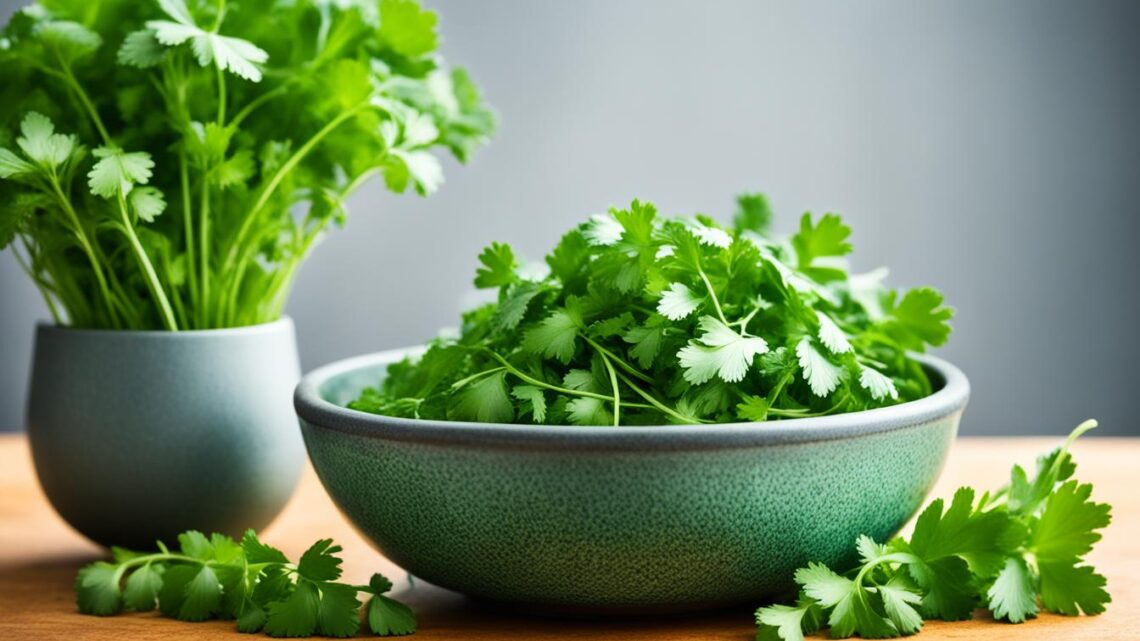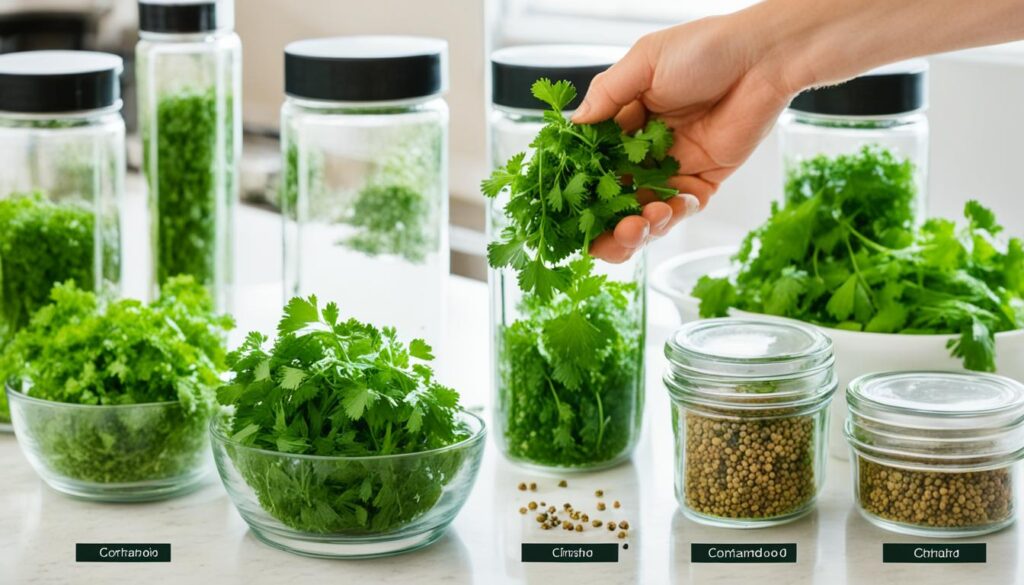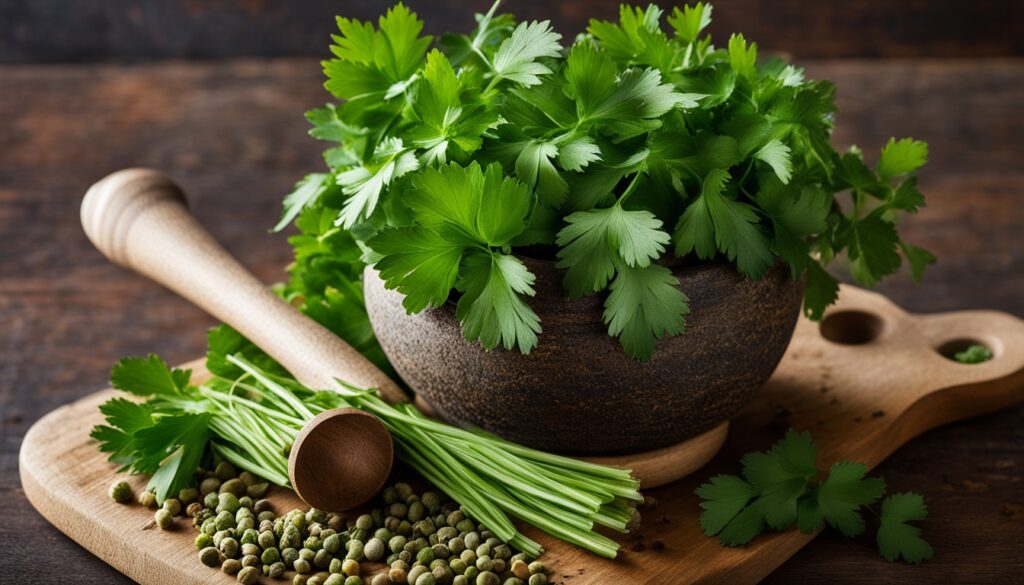
Cilantro, also known as Coriandrum sativum, is a versatile herb. It has been loved by cooks and health lovers for centuries. In the U.S., we call the fresh leaves and stems cilantro. The seeds are called coriander.
This guide will explore the many benefits and ways to use cilantro/coriander. It shows how both parts of the plant can make your meals better and help your health.
Cilantro and coriander add a rich flavor and are full of nutrients. They are important in many global dishes. If you want to improve your health or just make your food taste better, learning about cilantro and coriander is key.
What is Cilantro/Coriander?
Cilantro and coriander come from the same plant, Coriandrum sativum. This herb is an annual plant with a long history. It comes from the Mediterranean and Middle East.
The cilantro definition includes the fresh leaves and stems. These are used a lot in cooking. Coriander definition talks about the seeds. These seeds are a spice.
The differences between cilantro and coriander are big. Cilantro adds a fresh taste and smell to food. Coriander seeds give a warm, nutty taste. This is used in spice mixes and curries.
Both cilantro and coriander are in the Apiaceae family. This family includes many herbs and vegetables. Knowing this helps us understand how they grow and what they are used for. Cilantro has many names around the world. This shows how important it is in cooking and culture.
Culinary Uses of Cilantro/Coriander
Cilantro and coriander are key in many kitchens around the world. They add unique flavors to dishes. Knowing how to use them can open up new cooking ideas.
Flavor Profile of Cilantro and Coriander
Cilantro tastes fresh and citrusy with a hint of herbs. It’s perfect for Latin American and Asian dishes. It’s great in sauces, salads, and salsas.
Coriander seeds have a warm, nutty taste. They work well in both sweet and savory dishes. Together, cilantro and coriander make food taste amazing.
Popular Dishes Featuring Cilantro
Many dishes use cilantro and coriander. For example:
- Salsa, where fresh cilantro brightens up the flavors.
- Thai curries, which often incorporate both cilantro leaves and coriander seeds for depth.
- Salads, where cilantro adds freshness and complexity.
These dishes show how versatile cilantro is. They are loved by cooks and chefs everywhere.
How to Use Coriander Seeds in Cooking
Coriander seeds can be used in many ways. You can use them whole, ground, or in spice blends. Whole seeds add texture and flavor to pickles and marinades.
Ground seeds add warmth and depth to dishes. Trying different ways with coriander seeds can make your cooking better. For more on chili peppers, check out this guide.
Health Benefits of Cilantro/Coriander
Cilantro and coriander make food taste great and are good for your health. They help with detox, reduce swelling, and make your gut happy.
Detoxification Properties
Cilantro is great for cleaning out toxins. It has compounds that remove heavy metals from your body. Eating cilantro often can help your body get rid of toxins. It’s a good choice for those wanting to detox.
Anti-inflammatory and Antioxidant Effects
Cilantro is known for fighting inflammation and being an antioxidant. These benefits can prevent health problems and keep you feeling good. Eating cilantro can lower inflammation and fight oxidative stress. This is key for staying healthy.
Potential Benefits for Digestive Health
If you have digestive issues, cilantro might help. It can ease gas and bloating. Adding cilantro to your meals can make your digestive system work better.
| Health Benefit | Description |
|---|---|
| Detoxification | Helps cleanse heavy metals from the body |
| Anti-inflammatory | Reduces inflammation and promotes wellness |
| Antioxidant | Combats oxidative stress for better health |
| Digestive Health | Relieves symptoms like gas and bloating |
Nutritional Profile of Cilantro and Coriander
Cilantro and coriander come from the same plant but have different nutrients. They are great for your health. Cilantro is full of vitamins like A, C, and K. These vitamins help with your vision and keep you from getting sick.
Coriander seeds are also packed with minerals like potassium, magnesium, and calcium. These help with bone and muscle health. A single tablespoon of coriander seeds has more calories and nutrients than two ounces of cilantro leaves. This makes coriander seeds a better choice for nutrition.
Here is a table that shows the nutrients in cilantro leaves and coriander seeds.
| Nutrient | Cilantro Leaves (per 2 oz) | Coriander Seeds (per 1 tbsp) |
|---|---|---|
| Calories | 5 | 16 |
| Vitamin A | 1190 IU | N/A |
| Vitamin C | 7 mg | N/A |
| Vitamin K | 125 mcg | N/A |
| Potassium | 13 mg | 16 mg |
| Magnesium | N/A | 6 mg |
| Calcium | N/A | 6 mg |
Adding cilantro and coriander to your meals helps you get their unique nutritional profiles. This supports your health and wellness.
How to Grow Cilantro: Tips and Tricks
To grow cilantro well, pay attention to the right conditions and planting methods. Knowing the best conditions for cilantro helps you get a good harvest. Here are key tips and guidelines to make your growing experience better and your yield bigger.
Best Growing Conditions
Cilantro loves cool weather. The best times to plant are early spring or late summer. It does well in temperatures between 60°F and 75°F. But, it bolts easily in warmer weather, cutting short your harvest. So, picking the right conditions is key for great cilantro.
Planting and Harvesting Guidelines
Plant cilantro seeds directly in well-draining soil. Keep them about 6 to 8 inches apart for healthy growth. Here are some tips for planting and harvesting well:
- Choose a sunny spot with some shade to keep it cool.
- Water it often but don’t let it get too wet to avoid root rot.
- Pick leaves before they bloom for the best taste and quality.
- Let coriander seeds dry after blooming before you harvest them for next year.
Knowing how to balance the growing conditions of cilantro helps you get the most from your plants. This way, you can enjoy fresh cilantro in your cooking. Below is a table with important details on growing cilantro:
| Aspect | Details |
|---|---|
| Ideal Temperature | 60°F – 75°F |
| Soil Type | Well-draining, rich in organic matter |
| Sun Exposure | Full sun with partial shade |
| Spacing | 6 – 8 inches apart |
| Harvesting | Before flowering for leaves; after blooming for seeds |
How to Properly Store Cilantro and Coriander

Storing cilantro and coriander right makes them last longer. Follow these tips to keep your herbs fresh. You’ll enjoy their flavors for a longer time.
Storing Fresh Cilantro
Here’s how to keep cilantro fresh:
- Put the stems in a jar with water, like a bouquet. Make sure the leaves stay above the water. Then, cover them with a plastic bag.
- Wrap cilantro in a damp paper towel. Put it in a sealed plastic bag in the fridge. This keeps it moist but doesn’t drown it.
- Don’t wash cilantro before storing. Washing it can make it spoil faster.
Preservation Methods for Coriander Seeds
For coriander seeds, the right storage keeps them tasty:
- Keep coriander seeds in a cool, dark place. Use a sealed glass jar to block moisture and light.
- Use ground coriander within six months for the best taste. After that, it might not taste as good.
- Buying whole seeds lets you grind them fresh when you need to. This ensures your dishes taste their best.
| Storage Method | Cilantro | Coriander Seeds |
|---|---|---|
| In Water | Yes, like a bouquet | No |
| Wrapped in Damp Paper Towel | Yes | No |
| Sealed Glass Jar | No | Yes |
| Shelf Life | Up to 1 week | 1-3 years whole, 6 months ground |
Substitutes for Cilantro in Recipes
Looking for substitutes for cilantro? Try alternative herbs like parsley, basil, and mint. They can make your dishes taste fresh and new. Each herb has its own special taste that can replace cilantro well.
Parsley has a mild taste that’s great for salads, sauces, and garnishes. It adds brightness without being too strong. Basil tastes a bit sweet and peppery, perfect for Italian dishes. It goes well with tomatoes.
Mint brings a cool freshness to dishes. It’s great for Middle Eastern and Mediterranean foods. Use it in tabbouleh and yogurt sauces for extra flavor.
Here’s a quick overview of these substitutes:
| Substitute | Taste Profile | Best Uses |
|---|---|---|
| Parsley | Mellow and fresh | Salads, soups, garnishes |
| Basil | Sweet and peppery | Italian dishes, pesto, sauces |
| Mint | Fresh and cooling | Salads, yogurt dips, Middle Eastern dishes |
These substitutes don’t taste just like cilantro, but they’re great for adding new flavors. Try them out to make your dishes more exciting.
The Role of Cilantro in Traditional Medicine

Cilantro is known for its bright taste in food. It also has big roles in traditional medicine across cultures. For centuries, it has been used in many ways, showing its healing powers. Ancient texts from Rome and Egypt talk about its health benefits.
Today, cilantro is still used in herbal remedies for its health benefits.
Historical Uses of Cilantro/Coriander
For a long time, cilantro has been used in traditional medicine. People used it for:
- To help with digestion
- To fight infections because it has antibacterial properties
- To treat inflammation in joints
- To make people hungry and improve digestion
Modern Applications in Herbal Medicine
Now, cilantro is still a big part of herbal remedies. Its parts are studied for their benefits. They can:
- Reduce swelling
- Help control blood sugar
- Help clean the body
- Improve digestion and ease indigestion
Common Allergies and Reactions to Cilantro/Coriander
Cilantro and coriander are herbs that add flavor and health benefits to food. Most people find them safe. But, some may have cilantro allergies. These allergies can cause mild to severe reactions.
The most common symptoms are skin rashes and stomach issues like nausea. If you think you’re allergic, see a doctor for help. This is especially true if you have health issues or dental implants.
Knowing about cilantro allergies can prevent discomfort. It’s good to be aware before eating them.
Being aware of cilantro allergies makes cooking fun. Always check food labels for cilantro. It might be hidden in some foods.
Learn more about how food affects your health. Check out this link for info on herbs like onions and cilantro.
Fun Facts about Cilantro/Coriander

Cilantro is also known as coriander. It has a long history and many interesting facts. People use it in many cultures, not just for cooking but also for health reasons. This herb is loved worldwide for its taste and health benefits.
Historical Significance
People have used cilantro since ancient times. It was valued for its taste and health benefits. In ancient Egypt, cilantro was found in Tutankhamun’s tomb, showing how much it was valued.
Many cultures use cilantro in cooking and medicine. This has made it a key part of history.
Genetic Differences in Taste Perception
How you taste cilantro might be different from others. Research says about 20% of people think cilantro tastes soapy. This shows how our genes can affect what we like or dislike about certain foods.
Learning about cilantro can make cooking more fun. Try adding it to a tasty chickpea pasta salad. This dish highlights cilantro’s bright flavor and versatility.
Simple Recipes Featuring Cilantro
Cilantro adds a fresh taste to many dishes. It makes them taste better and more vibrant. Here are easy cilantro recipes like a zesty chimichurri sauce and salad ideas. These recipes show how cilantro can make different dishes better.
Cilantro Chimichurri Sauce
This chimichurri sauce is great with grilled meats and veggies. To make it, mix together:
- 1 cup fresh cilantro, chopped
- 3 cloves garlic, minced
- 1/4 cup red wine vinegar
- 1/2 cup extra virgin olive oil
- 1 teaspoon red pepper flakes (optional)
- Salt and pepper to taste
Put all ingredients in a bowl and let it sit for 30 minutes before serving. This sauce is perfect with grilled steak or roasted veggies.
Refreshing Cilantro Salad Recipes
Cilantro is great in salads too. Try a chickpea pasta salad that’s both tasty and healthy. You’ll need:
- 8 ounces of rotini, fusilli, or farfalle pasta
- 1 can (15 ounces) chickpeas, drained
- 3 tablespoons extra virgin olive oil
- 3 tablespoons lemon juice
- 2 tablespoons mustard
- 1½ tablespoons maple syrup
- 1 teaspoon dried oregano
- ½ teaspoon garlic powder
- 1 teaspoon salt
- ⅛ teaspoon black pepper
Cook the pasta in boiling water with 1 tablespoon of salt until it’s al dente. Then, rinse it under cold water. In a bowl, mix the dressing ingredients. Add the pasta, chickpeas, and lots of chopped cilantro. This salad keeps well in the fridge for 3 to 4 days.
These simple recipes show how versatile cilantro is. It makes sauces and salads taste better and is healthy too. For more ideas on using Brussels sprouts, check this guide.
Popular Herb Comparisons: Cilantro versus Other Fresh Herbs
Cilantro is a standout among fresh herbs, often compared to parsley, basil, and mint. Its citrusy flavor adds a unique twist to dishes. Fresh herbs like cilantro make food taste better. Knowing their unique tastes helps you pick the right ones for your dishes.
When comparing cilantro to parsley, we see a big flavor difference. Parsley tastes mild and earthy, while cilantro adds a bold flavor. In fact, about 30% of recipes with fresh herbs include cilantro. This shows how much people love using it in cooking.
Basil and mint are also popular fresh herbs, each with their own taste. Basil adds sweetness to Italian dishes, while mint is great in desserts and drinks. But cilantro is mostly used in ethnic dishes, especially in grain bowls, in about 25% of recipes.
If you can’t find cilantro, parsley can be a good substitute, but it won’t have the same zing. Cilantro is used in both vegetarian and non-vegetarian dishes, showing its wide appeal. It’s unique in salad dressings, with 60% of people preferring cilantro-based ones.
Cilantro is often found in Mediterranean dishes, showing its wide use in different cuisines. It’s also a healthy choice, making it popular with those watching their diet. Adding cilantro to your meals can make them tastier and healthier. For example, a fregola pasta salad with grilled shrimp uses cilantro to boost flavor and nutrition. Check out the recipe here.
Environmental Benefits of Growing Cilantro/Coriander
Choosing to grow cilantro or coriander does more than just add to your cooking. It also helps the planet. These herbs attract good insects, making your garden a home for pollinators. This is key for our food supply.
Growing your own herbs cuts down on carbon emissions. It means less energy spent moving herbs from farms to stores. Cilantro grows well with care and keeps pests away with its strong smell. This cuts down on the need for harmful chemicals.
Using Integrated Pest Management (IPM) helps keep your garden healthy. This method fights pests without harsh chemicals. By growing cilantro, you help make the planet healthier. Small actions like this can make a big difference for your kitchen and the earth.



